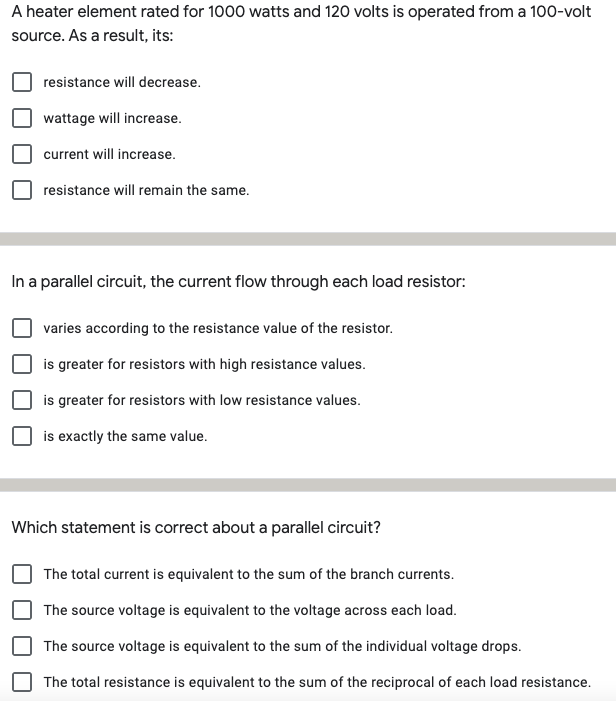A heater element rated for 1000 watts and 120 volts is operated from a 100-volt source. As a result, its:
A heater element rated for 1000 watts and 120 volts is operated from a 100-volt source. As a result, its:
Introductory Circuit Analysis (13th Edition)
13th Edition
ISBN:9780133923605
Author:Robert L. Boylestad
Publisher:Robert L. Boylestad
Chapter1: Introduction
Section: Chapter Questions
Problem 1P: Visit your local library (at school or home) and describe the extent to which it provides literature...
Related questions
Question
PLEASE ANSWER ALL OF THE GIVEN QUESTIONS.
I will rate you with “UPVOTE/LIKE” if you answer all of the questions.
I will rate you with “DOWNVOTE/DISLIKE”, if you don’t answer all of the questions.
THANK YOU FOR YOUR HELP.

Transcribed Image Text:A heater element rated for 1000 watts and 120 volts is operated from a 100-volt
source. As a result, its:
resistance will decrease.
wattage will increase.
current will increase.
resistance will remain the same.
In a parallel circuit, the current flow through each load resistor:
varies according to the resistance value of the resistor.
is greater for resistors with high resistance values.
is greater for resistors with low resistance values.
is exactly the same value.
Which statement is correct about a parallel circuit?
The total current is equivalent to the sum of the branch currents.
The source voltage is equivalent to the voltage across each load.
The source voltage is equivalent to the sum of the individual voltage drops.
The total resistance is equivalent to the sum of the reciprocal of each load resistance.
Expert Solution
This question has been solved!
Explore an expertly crafted, step-by-step solution for a thorough understanding of key concepts.
This is a popular solution!
Trending now
This is a popular solution!
Step by step
Solved in 3 steps

Knowledge Booster
Learn more about
Need a deep-dive on the concept behind this application? Look no further. Learn more about this topic, electrical-engineering and related others by exploring similar questions and additional content below.Recommended textbooks for you

Introductory Circuit Analysis (13th Edition)
Electrical Engineering
ISBN:
9780133923605
Author:
Robert L. Boylestad
Publisher:
PEARSON

Delmar's Standard Textbook Of Electricity
Electrical Engineering
ISBN:
9781337900348
Author:
Stephen L. Herman
Publisher:
Cengage Learning

Programmable Logic Controllers
Electrical Engineering
ISBN:
9780073373843
Author:
Frank D. Petruzella
Publisher:
McGraw-Hill Education

Introductory Circuit Analysis (13th Edition)
Electrical Engineering
ISBN:
9780133923605
Author:
Robert L. Boylestad
Publisher:
PEARSON

Delmar's Standard Textbook Of Electricity
Electrical Engineering
ISBN:
9781337900348
Author:
Stephen L. Herman
Publisher:
Cengage Learning

Programmable Logic Controllers
Electrical Engineering
ISBN:
9780073373843
Author:
Frank D. Petruzella
Publisher:
McGraw-Hill Education

Fundamentals of Electric Circuits
Electrical Engineering
ISBN:
9780078028229
Author:
Charles K Alexander, Matthew Sadiku
Publisher:
McGraw-Hill Education

Electric Circuits. (11th Edition)
Electrical Engineering
ISBN:
9780134746968
Author:
James W. Nilsson, Susan Riedel
Publisher:
PEARSON

Engineering Electromagnetics
Electrical Engineering
ISBN:
9780078028151
Author:
Hayt, William H. (william Hart), Jr, BUCK, John A.
Publisher:
Mcgraw-hill Education,